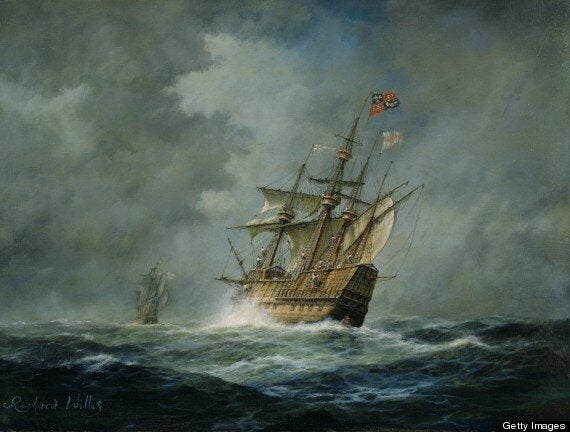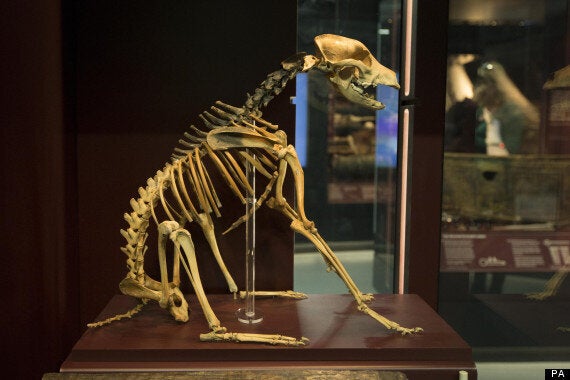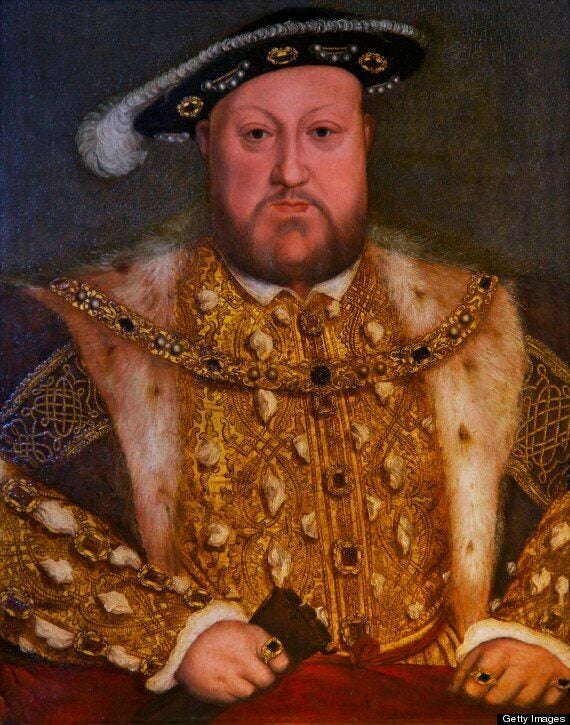Forensic scientists have revealed the faces of eight of the crew on board Henry VIII's The Mary Rose when it sank off Portsmouth during battle with the French in 1545.
The analysis of skeletons and skulls retrieved from the Tudor gunship has resulted in these artist’s impressions of the Bosun, Cook, Purser, Royal Archer, Master Gunner, Carpenter, Ologies Archer and Stranger Gentleman.
The images come as a £27m museum opens on Thursday in Portsmouth’s Historic Dockyard, the same place the ship was built in 1510.
Scroll down for more pictures

Facial reconstructions of the crew based on forensic science examinations of their skulls and skeletons (top row from left) Bosun, Carpenter, Cook, Master Gunner and (bottom row from left) Ologies Archer, Purser, Royal Archer and Stranger Gentleman
The “jewellery box” centre, designed by Wilkinson Eyre and with interiors by Pringle Brandon Perkins+Will architects, brings together the wreck of the shop along with thousands of artefacts for the first time since they were lifted from the seabed more than 30 years ago.
According to The Times, some 92 of the 179 sets of human remains discovered have been reassembled, although only a handful are on display.
Archaeological director Dr Alex Hildred said: "One of them is an archer. We know that because he has a certain condition in his shoulders," still observed in modern archers, indicating regular strain.
Other crew have been identified by analysis of their clothing, tools and musculature structure. The man believed to be the Purser was found in a small store room containing a chest of gold and silver coins and the cook is believed to have been a man in his 30s who spent much of his life bent over.
What’s more – scientists have began work on extracting DNA from the bones of the human skeletons found on board the ship – with a view to identifying the men and perhaps even tracing their living relatives.

The Mary Rose sank while leading an attack on a French invasion fleet
Dr Nick Owen, a sports biomechanics expert at Swansea University who has been leading the team examining the human remains, told The Telegraph: “Ultimately we would like to find some living relatives, although there are no records of those who were on board so it will be like searching for one blade of grass in a field.
“It would be marvellous if we could narrow it down to families and it is known that archers for example came from certain parts of the country like Wales, so that gives us a bit of a pointer.
“We will be putting in an application for funding to do the DNA work later this year.”
The ship lay undiscovered on the seabed of the Solent for centuries until its exposed timbers were seen by divers in 1971.
After extensive excavations, supported by Prince Charles who dived on the wreck site, more than 60 million people watched as the hull section was lifted to the surface on October 11 1982.

The reconstructed timbers of The Mary Rose
The wreck was placed in a museum where it has been sprayed with water and then a preservative until just last month.
But its artefacts were housed separately and now the Mary Rose Trust believes it has the home it deserves to show off the wealth of treasures.
Located next to Nelson's flagship HMS Victory, the museum includes a wide range of items from 500-year-old nit combs to longbows and a favourite of visitors, the skeleton of the ship's dog Hatch.
Chief executive John Lippiett said: "The new Mary Rose Museum marks a new and exciting chapter in the history of The Mary Rose, providing an astonishing resource for the world to learn about the Tudors and a centre of excellence for maritime archaeology and conservation.
"The museum is testament to all those who have worked so hard on this remarkable 42-year project to locate, salvage and conserve the ship and her contents."

The bones of 'Hatch,' the ship's dog
Lippiett described how the layout was designed in the shape of a ship with the hull on one side and many of the artefacts laid out in a mirror image allowing visitors to experience how it would have felt to be onboard.
He said: "The whole of the museum is designed by the curvature of the ship. The concept is to put the objects back into the ship. We have built the mirror image half of the ship.
"This is a state-of-the-art museum which is at a very top level of any museum I know."
He said the displays centred around actual crew members with their personal and professional items laid out and explained.
Lippiett said: "It is a memorial to the 500 who lost their lives on the Mary Rose.
"If I died in battle and I saw what was being done in my memory, I would be absolutely thrilled. This is the most extraordinary time capsule of life and death 500 years ago.

A canon recovered from the wreck
"This isn't just about a ship, it's about life in Tudor times. It isn't just a time capsule though, it rewrites history; historians said that gimballed compasses didn't come in for another 100 years but we have three of them here.
"The only problem we have is that people are so fascinated they won't want to leave, it's a good problem to have."
The museum has been praised by historians and prominent supporters including Dr David Starkey.
He said: "The Mary Rose is the English Pompeii, preserved by water, not fire.
"All Tudor life is there, it is like stepping inside a Holbein painting."

The Mary Rose sank off Portsmouth, in full view of Henry VIII
John Bly, author and broadcaster, said: "The Mary Rose Museum is the closest thing to time travel I have ever experienced.
"Tudor life surrounds you and welcomes you in."
The total cost of the project to conserve and house the only 16th century warship on display in the world has cost £35 million, with the Heritage Lottery Fund (HLF) providing more than £32 million during the past 18 years.
Dame Jenny Abramsky, HLF chairwoman, said: "The drama of the day the Mary Rose was raised from the depths of the Solent is forever seared in my memory - the most significant archaeological find in our nation's maritime history.
"Right from the start, the Heritage Lottery Fund has worked closely with the Mary RoseTrust on this ground-breaking project to reunite the 500-year-old warship with thousands of artefacts telling her story.

The £27m museum in Portsmouth
"It's incredibly exciting that, after much painstaking conservation work, the Mary Rose is finally ready to go back on show in a wonderful new space where she will undoubtedly wow all who come to visit."
The Mary Rose Museum at Portsmouth Historic Dockyard, the same place where the ship was built in 1510, opens to visitors on May 31.
A celebratory launch day is being held on Thursday which will start with a wreath-laying ceremony at the wreck site in the Solent followed by a gun salute and water cannon display as the Mary Rose bell becomes the last item to be brought to the new museum.
A flaming arrow volley will then be fired at Southsea Castle, the place where Henry watched the Mary Rose sink, before the new museum is revealed from behind a giant Tudor standard flag.